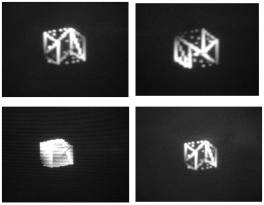DREAM VISIO
DREAM VISIO is a 3D Graphics
Processing Unit (GPU) system which incorporates a custom made CPU and a rendering engine to display
any 3D objects on the VGA. The choice of making a graphics processor was driven
by the fact that, this would be the first 3D graphics system built for this
course.
DREAM VISIO
has two main parts viz., CPU
and Rasterizer. Each 3D
object is first broken into a finite number of triangles. Our graphics system works on
these triangles to create a 3D image of the object. Normally there are many
vertices that are common between different triangles. So to reduce the time
spent in doing the geometric transforms we made our processor by working on
vertices rather than triangles. First all the geometric transforms are done on
the vertices by the CPU using its float point instructions. These vertices are
then given to the Rasterizer which renders the triangles and generates pixel
level information of each image. These rendered images are then displayed on
Monitor using the VGA module.

[Project Website of 3D GPU]
System Gimmicks And Features
 |
CPU
ARCHITECTURE:
 |
Basic
Type: RISC 5 stage pipeline |
 |
Floating
Point Capability: yes (16-bit Format) |
 |
Word
size: 16-bits |
 |
Integer/Floating
Point Registers: 32 |
 |
Specialized
instructions: yes |
 |
Special
Arithmetic Unit: Floating Point MAC, Reciprocal |
 |
Harvard
Architecture |
 |
Processing
Power: 1000 vertices per second |
 |
Hazard
Detection Unit: Detects all structural, data and control hazards. |
|
 |
Memory Architecture:
 |
Data per CPU clock
cycle: 4 words/CPU clock. |
 |
Memory Speed: 12.5 MHz |
|
 |
Rasterizer Organization:
 |
Function: Interpolates
color and screen co-ordinates for all the pixels in triangle. |
 |
Specialized Units: 8-bit
divider. |
 |
Throughput: Close to 1
pixel per clock cycle. |
|
 |
VGA:-
 |
Aspect Ratio: 256 x 480
pixels |
 |
Operating Frequency:
12.5 MHz |
|
 |
Software Support:-
 |
Verification for hardware implementation: Available for all modules. |
 |
Assembler: yes |
 |
CPU Simulator: no |
 |
Rasterizer Simulator:
yes |
|
 |
Device utilization summary:
 |
Number
of External GCLKIOBs
1 out of 4 25%
|
 | Number
of External IOBs
106 out of 166 63%
|
 |
Number
of LOCed External IOBs 105 out of 106
99%
|
 |
Number
of BLOCKRAMs
8 out of 28 28%
|
 |
Number
of SLICEs
3131 out of 9408 33%
|
 |
Number
of DLLs
1 out of 4
25%
|
 |
Number
of GCLKs
3 out of 4 75%
|
 |
Number
of TBUFs
122 out of 9632 1%
|
|